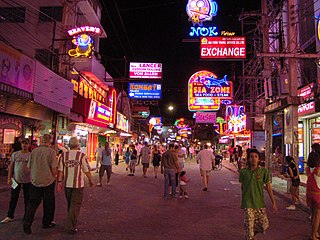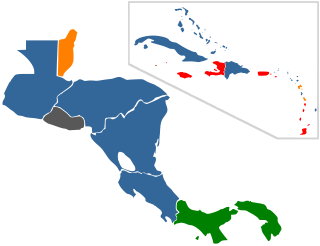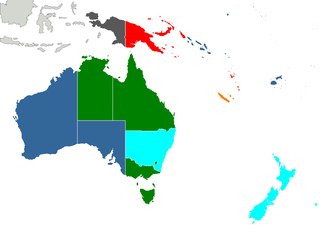Related Research Articles

Prostitution in Thailand is illegal. However, due to police corruption and an economic reliance on prostitution dating back to the Vietnam War, it remains a significant presence in the country. It results from poverty, low levels of education and a lack of employment in rural areas. Prostitutes mostly come from the northeastern (Isan) region of Thailand, from ethnic minorities or from neighbouring countries, especially Cambodia, Myanmar, and Laos. UNAIDS in 2019 estimated the total population of sex workers in Thailand to be 43,000.
Prostitution in Senegal is legal and regulated. Senegal has the distinction of being one of the few countries in Africa to legalize prostitution, and the only one to legally regulate it. The only condition that it is done discreetly. Prostitution was first legalised in 1966. UNAIDS estimate that there are over 20,000 prostitutes in the country. The average age for a sex worker in Senegal is 28 years old and female.
Prostitution in Colombia is legal, regulated and limited to brothels in designated "tolerance zones". Sex workers are required to have regular health checks. However, the laws are rarely applied and prostitution is widespread, partly due to poverty and internal displacement.
Prostitution in Belize is legal, but the buying of sexual services is not. Associated activities such as operating a brothel, loitering for the purposes of prostitution and soliciting sex are also illegal.
Prostitution in Kenya is widespread. The legal situation is complex. Although prostitution is not criminalised by National law, municipal by-laws may prohibit it.. It is illegal to profit from the prostitution of others, and to aid, abet, compel or incite prostitution.. UNAIDS estimate there to be 133,675 prostitutes in the country.
Prostitution in Sierra Leone is legal and commonplace. Soliciting and 3rd party involvement are prohibited by the Sexual Offences Act 2012. UNAIDS estimate there are 240,000 prostitutes in the country. They are known locally as 'serpents' because of the hissing noise they use to attract clients.
Prostitution in Cameroon is illegal but tolerated, especially in urban and tourist areas. In the capital, Yaoundé the main area of prostitution is the neighbourhood of Mini Ferme. UNAIDS estimate there are 112,000 sex workers in the country.
Prostitution in Azerbaijan is illegal but common. Prostitution is an administrative offence and punishable by a fine. Keeping a brothel is a criminal offence and punishable by up to 6 years' imprisonment. In 2017 a draft law proposing to add heavy fines to the punishment for keeping a brothel was before the National Assembly. It has been estimated that there are 25,054 prostitutes in Azerbaijan, some of which are aged 15 to 18.
Prostitution in Suriname is illegal but widespread and the laws are rarely enforced. Human trafficking and Child prostitution are problems in the country. Prostitutes are known locally as "motyo". UNAIDS estimate there to be 2,228 prostitutes in the country.
Prostitution in Guyana is illegal but widespread. Prostitution law is antiquated and dates from the colonial era. Law enforcement is inconsistent and sex workers report violence and abuse by the police. Many turn to prostitution for economic reasons and the lack of other job opportunities. Prostitution continues to receive greater public attention due to the high incidence of HIV/AIDS among prostitutes. Prostitution in the country is separated into three types: "uptown", servicing affluent clients, "downtown", servicing the working classes, and mining sites. UNAIDS estimate there to be 6,000 prostitutes in the country.
Jamaica is a source, transit, and destination country for adults and children trafficked for the purposes of sexual exploitation and forced labor.
Prostitution in Burkina Faso is not specifically prohibited by the law, but soliciting and pimping are illegal. Burkinabe society only accepts sexual intercourse within marriage. In 2009, Voice of America reported that the number of prostitutes in Burkina Faso had increased as a result of the country's poverty. The increase in prostitution has given rise to fears of an increase in the number of Burkinabés infected with HIV and AIDS. UNAIDS estimate there to be 31,000 prostitutes in the country.
Prostitution in Eswatini is illegal, the anti-prostitution laws dating back to 1889, when the country Eswatini was a protectorate of South Africa. Law enforcement is inconsistent, particularly near industrial sites and military bases. Police tend to turn a blind eye to prostitution in clubs. There are periodic clamp-downs by the police.
Prostitution in Mongolia is illegal but widespread in some areas. The Global Fund for Tuberculosis, HIV/AIDS and Malaria estimated there were about 19,000 sex workers in the country in 2006. Many women in Mongolia turn to prostitution through poverty.
Prostitution in Madagascar is legal, and common, especially in tourist areas. Related activities such as soliciting, procuring, living off the earnings of prostitution or keeping a brothel are prohibited. Public Order laws are also used against prostitutes. There are recent laws against "consorting with female prostitutes". People caught paying for sex with children under 14 can face criminal penalties of up to 10 years imprisonment. This is strictly enforced against foreign tourists. As well as in the tourist areas, prostitution also occurs around the mining towns of the interior such as Ilakaka and Andilamena. It was estimated that there were 167,443 sex workers in the country in 2014.
Prostitution in Benin is legal but related activities such as brothel keeping and benefiting from the prostitution of others are illegal. UNAIDS estimates there to be about 15,000 prostitutes in the country. Most of these are migrants from neighbouring countries, mainly Nigeria, Togo and Ghana. Only 15% of the prostitutes are Beninese. Prostitution occurs on the streets, in bars, restaurants, hotels and brothels. With advent of the smartphone, many prostitutes use apps to make arrangements with clients.

Legality of prostitution in the Americas varies by country. Most countries only legalized prostitution, with the act of exchanging money for sexual services legal. The level of enforcement varies by country. One country, the United States, is unique as legality of prostitution is not the responsibility of the federal government, but rather state, territorial, and federal district's responsibility.

Prostitution in Oceania varies greatly across the region. In American Samoa, for instance, prostitution is illegal, whereas in New Zealand most aspects of the trade are decriminalised.
Prostitution in the Bahamas is legal but related activities such as brothel keeping and solicitation are prohibited. The country is a sex tourism destination, including 'all in' tours. UNAIDS estimate there are 3,000 prostitutes in the Bahamas.
Prostitution in Barbados is legal but related activities such as brothel keeping and solicitation are prohibited. The country is a sex tourism destination, including female sex tourism.
References
- 1 2 "Women who travel for sex: Sun, sea and gigolos". The Independent. 9 July 2006. Archived from the original on 23 December 2008. Retrieved 22 December 2017.
- ↑ "Popular Caribbean Sex Tourism Destinations". Jamaica Inquirer. Retrieved 22 December 2017.
- ↑ "Sexuality, Poverty and Law Programme". Institute of Development Studies. Retrieved 22 December 2017.
- ↑ "Sex workers: Population size estimate - Number, 2016". www.aidsinfoonline.org. UNAIDS. Archived from the original on 4 June 2019. Retrieved 21 July 2018.
- 1 2 3 Joseph, Andrew (8 November 2016). "The Horniest Countries in the Caribbean". Pellau Media. Retrieved 22 December 2017.
- ↑ "16 Caribbean Nations Where Sex Trafficking Remains A Problem | News Americas Now:Caribbean and Latin America Daily News". News Americas Now. 30 June 2016. Retrieved 30 December 2017.
- 1 2 3 4 Kempadoo, Kamala (2004). Sexing the Caribbean : gender, race, and sexual labor. New York [u.a.]: Routledge. ISBN 978-0415935036.
- ↑ Bureau of International Labor Affairs (ILAB) - U.S. Department of Labor Archived 13 May 2009 at the Wayback Machine . Dol.gov. Retrieved on 30 March 2011.
- 1 2 Reid, Tyrone (25 September 2011). "A PERSONAL STORY - Teen prostitute speaks" . Retrieved 30 November 2012.
- ↑ "Jamaica SW Coalition". Global Network of Sex Work Projects . 29 November 2010. Retrieved 8 March 2020.
- ↑ "Jamaica 2018 Trafficking in Persons Report". U.S. Department of State. Archived from the original on 29 July 2018. Retrieved 28 July 2018.
 This article incorporates text from this source, which is in the public domain .
This article incorporates text from this source, which is in the public domain . - ↑ "Jamaica not hard enough on human traffickers - US State Department". 28 June 2011. Retrieved 30 November 2012.